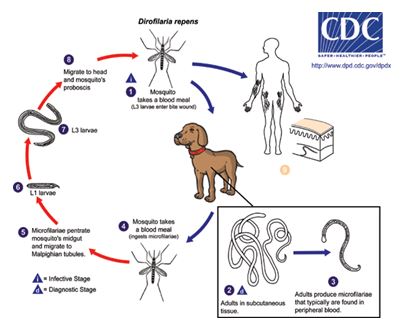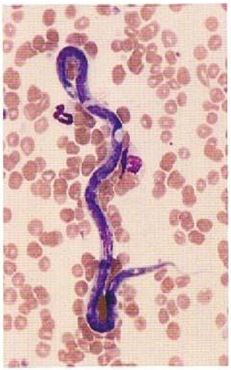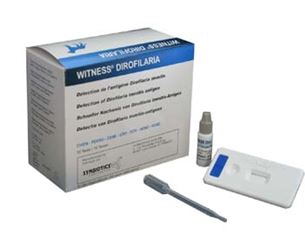Néhány gondolat a Szívférgességről
Carnivorous animals, such as dogs and cats is a parasite belonging to several species occur Dirofilaria family, two of which also occur in Hungary. One of the dirofiláriózist heart, that the cause heartworm Dirofilaria immitis, and the other is a species Dirofilaria repens, which is very common in Hungary. The latter causes skin that is bőrférgességet dirofiláriózist. The heartworm is quite large, up to 30 cm in length may reach adulthood. Dogs, cats heart, respectively. the lungs alive.
Infection

Contributors two infection is in this sense necessary: one for the final host to which is most often a dog, on the other hand between a host to which a mosquito. The spread of the pathogen in the intermediate host, that is, the absence of mosquitoes can not be built because it is formed in the shape of infectious (L3) and he quenches it in the next administrator. The incubation period for the disease takes 6-9 months. Adult females for a longer time than 5 years mikrofiláriákat able to produce, which can remain viable for up to 2.5 years in vérpályában. To microfilariae absorbed by the mosquitoes are able to evolve, there is a need for at least 14 ° C external temperature. Temperature below shapes located in the mosquito able to suspend their development and then it flow when the temperature rises again. The higher the ambient temperature, the faster the development takes place in the mosquito.
Symptoms of the disease
As the adult worms settle in for the first time in the pulmonary artery at the first symptoms of which can add up, even though the right side of the heart worms living in the heart for a long time do not cause any symptoms, that remain hidden. More worm located in a dog, as a longer time and the more active lifestyles of the animal, the more severe symptoms. Mild cough initially formed. This is usually one of the first and most characteristic symptom of the disease as well. The later increased cough and difficulty in breathing accompanied it. Exercise more and more stress for the patient, soon tired and coughing. A lot of moving, active, athletic animals before symptoms appear and the disease is more severe.

Diagnosis
Detection of heartworm disease is not an easy task.
The simplest method is the direct examination of blood when trying to detect the presence of microfilariae. This can be done locally, veterinary surgeries, is a relatively simple and fast native blood test, but this test does not allow the separation of Dirofilaria immitis and D. repens mikrofiláriáinak.
The test is much more sensitive to the so-called native. serological tests. They are also important because of the dogs infected with heartworms about 20% of the blood of absolutely no microfilariae. (eg.. against former microfilariae treatment too early testing, etc.) is important to know that the number of microfilariae shows a diurnal variation. Night is more than during the day, so the blood tests, preferably in the early morning or in the evening to take place.

The serologically negative test result does not mean that the animal is not infected with D. immitis certainly Nations. This can only be obtained when the test was repeated for 6 months later when the animals received an effective preventive treatment. It is recommended to repeat the serologic test after 4-6 months of treatment adulticidal to clarify remaining in D. immitis live in the patient. If a dog microfilariae are found in all cases it should be performed by a serological test to clarify that the animal heart worm or worm disease causes the skin carries.
The diagnosis is therefore made the following strategies:
First year is recommended in the native blood tests carried out on one occasion, which is a relatively inexpensive process and which are usually all species Dirofilaria mikrofiláriája detected.
2 of microfilariae positive individuals, and all the heartworm existence of suspicious symptoms (cough, fatigue), we recommend serological test showing a dog examined by D. immitis presence.
3 of increasingly exposed to the risk of infection (held outdoors, walking a lot, hunter, 1-8 years old) in dogs is recommended annually to repeat the serological test and / or maintain the continuous preventive treatment.
The above method is very high efficiency filter out the animals concerned, of course, 100% accuracy is not provided. In addition to the direct or indirect detection of pathogens in blood examination, chest radiography departments, as well as ultrasound examination of the heart may help the lesions are detected.
Therapy
The heartworm treatment of serious challenges for every practice!
In the treatment of adult (adult) worms "adulticides", while the mikrofiláriákat "mikrofilaricid try to destroy" preparations.
The adulticidal preparations of arsenic derivatives, which are not available in Hungary, but some EU countries do, that is be purchased. Good efficient use of the product in the United States soon Immiticide®, which melarsomine the active ingredient. This does not affect the mikrofiláriákra melarsomine or L3 and L4 development shapes. Is used, the biggest problem is that of dead adult heart worms or parts of the treatment and thromboembolism érelzáródásokat inevitably cause the patient's lungs. Following the submission of the adult worms die in a matter of days or weeks. This may take up to a month. This is not a defect, but rather the benefits of the drug, since a large amount of simultaneous destruction of vermin and would still need to be prepared after the onset of symptoms of thromboembolism treatment adulticidal extremely high risk.
Mikrofilaricid products produced and there are many dogs in one of these times is available here. Because, like the adult worms destroy the microfilariae first treatment against serious complications may, therefore, closely monitored hospital setting if possible, carried out on animals. The second and subsequent treatments are generally no longer require such precautions.
Prevention
To prevent possible contamination on two fronts:
1. the mosquitoes away holding
2. inoculated by the mosquito infective form (L3) destruction.
The product also many mosquitoes repellent (repellent) affects (spot on preparations or collar), but there is no perfect defense against them, however, since even in homes can occur even after a month szúnyogszezont well. All dogs, but at least the infection is highly exposed to the mosquito the entire time recommended a preventive (prophylaxis suitable) product is constantly handled. These you should know that the larvae destroy all that has been introduced into the animal within a month, monthly application is recommended for the entire duration of the mosquito. Although the effect is different in many respects, it is virtually 100% able to prevent the infection of dogs. They are killing the adult worms are not suitable, although there are some observations that some preventive compositions shorten their life. Moreover, the preventive activity against many other parasites agent helminths or there. The pre-treatment puppy should begin no later than 8 weeks of age.
Valentine dr.Talpag
source:
Charles dr.Csikós (Paws Veterinary Clinic), www.haziallat.hu, www.hungarovet.hu, www.peteducation.com
